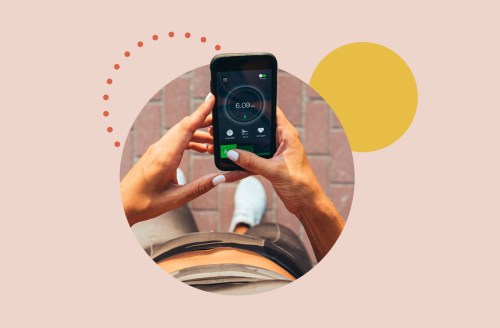Artificial Intelligence Is Changing the World of Digital Fitness—Here’s What To Know
Artificial intelligence in fitness applications is booming. Here, experts discuss how A.I. technology is changing the world of digital fitness.

Historically, to get the most individualized attention and assistance with your fitness regimen, you needed to turn to (and shell out for) a personal trainer. But times are a-changin’. Now, advancements in artificial intelligence (A.I.) are bringing that same sort of feedback-based personalization to the digital fitness space, making the experience of having a personal trainer more accessible than ever for those without bottomless pocketbooks or gym memberships.
Experts in This Article
Jim Huether is the CEO of Hyperice, a brand that uses recovery and movement enhancement technology, utilizing ice, heat, percussion, and vibration.
Mo Iqbal is the founder and CEO of Sweatworks, a digital fitness company.
Trent Ward is the founder and CEO of Forme Life, a fitness company which sells a smart mirror with a weight training system built in.
Back in 2017, market research done by ReportLinker estimated that the global digital fitness industry would grow 33 percent to reach $27.4 billion by 2022, and—judging by the mega boom of workouts that moved to the digital space due to COVID-19—it’s well on its way to meet that projection (and then some). Now, A.I. is being used to make at-home workouts safer, more personal, and as close to an in-studio experience as possible (all the more alluring since the ability to hit up a gym or fitness class may not happen anytime soon). Innovators are utilizing A.I. in two major ways: with form-adjusting technology through apps and pieces of fitness equipment, and by learning your exercise and recovery behavior to make personalized recommendations.
To be clear, A.I. isn’t new, but it’s newly making waves in the fitness space. “A.I. is being implemented by looking at your data and what you’re doing to suggest something that might be a fit for you,” says Mo Iqbal, founder and CEO of Sweatworks, a digital product development company that works with fitness brands on technology applications. Data collection usually happens via a wearable that collects your steps and sleep, and tapping into A.I., it can tell you how hard your effort was during a workout by learning your physical behavior over time and adjusting feedback based on that behavior. “That feedback is constantly adjusted,” says Iqbal. Take the wearable Whoop, for instance: The app can guestimate your performance strain on day one by comparing you to others in your cohort, but over time, thanks to A.I., it can actually learn how you’ll respond and what it will take to get you back on your feet.
The type of A.I. that personalizes workout recommendations is also known as machine learning, which is a technology that uses complex algorithms to find patterns in data. It’s worth pausing here to explain that A.I. is, at its most basic level, a highly advanced algorithm (think: an algorithm is a caterpillar and A.I. is a butterfly). “Elite athletes have the opportunity for a coach to see what they’re doing,” says Trent Ward, founder and CEO of Forme Life, a soon-to-launch screen-based piece of fitness equipment that offers form feedback and personalized workout tips (pricing starts at $58/month for 39 months for the screen-only studio, or $110/month for 39 months for the full studio with workout accessories). “With A.I., now that type of recommendation and expert-backed advice is becoming accessible to the average consumer athlete.”
Trainers believe that the individualization in at-home workouts is going to make fitness better—and smarter—for everyone.
Ward believes that the individualization in at-home workouts is going to make fitness better—and smarter—for everyone. “A.I. is taking the human element out of trying to decide these things like what workout to do or how to recover, which is going to be reassuring for the consumer to know that they’re doing the right workout,” he says.
Besides Forme Life, recovery tech brand Hyperice launched an app this month that connects your recovery device (the Hypervolt, for instance) to your wearable and customizes routines for you based on your activity, steps, and the duration of your workouts. “We’re pulling in all of this data, analyzing and interpreting it, and making it personalized for you, giving you recommendations so that you can actually improve your health,” says Jim Huether, CEO of Hyperice. Say you ran and beat your personal record one day—your app will know you just performed at a high-intensity and suggest a lower-body recovery routine.
The thinking with this technology is that when you’re doing the right workout for your body on a given day, you’ll also be better able to perform movements in the right way. When you don’t use proper form, A.I. adjustments help you to monitor your alignment and how you execute certain moves. This summer, digital strength training weight system Tonal introduced its form feedback feature, which uses sensors within the machine’s Smart Handles and Smart Bar to guide you through your movements (feedback shows up on the screen through alerts that tell you how to tweak your form along with a photo of what proper form looks like).
While this is a top-of-the-line piece of equipment (it costs $2,995 plus $49/month for membership), there are also less expensive workout apps that are doing the same thing. The recently launched Yoganotch ($249) gives you wearable 3-D motion sensors to guide you through poses, while apps Onyx ($80 for a lifetime membership) and Cure.fit (currently free until the end of October) use a 3-D motion capture system through your phone’s camera to analyze your movement and make form suggestions if something is misaligned.
Utilizing this form-bettering technology will be the key to surviving in the post-pandemic fitness world, says Iqbal, especially since many believe home workouts are here to stay. For several months now, many industry pros (including Well+Good!) have speculated that, on the other side of the quarantine, we’ll be adopting an omnichannel approach to fitness, in which fitness studios offer both IRL and digital classes. That hybrid approach to workouts is what A.I. is already enhancing: It helps you to work harder, better, and smarter. You can truly have it all in at-home fitness via your smartphone and computer.
“Technology can add some level of quantification [to your workouts], which is going to be reassuring to the consumer to know that they’re doing the right thing,” says Ward. “And then they’ll have better outcomes.” Your home gym is about to become much more intelligent.
Here’s what happened when one W+G staffer went to a bio-hacking gym that uses A.I. in its equipment:
Sign Up for Our Daily Newsletter
Get all the latest in wellness, trends, food, fitness, beauty, and more delivered right to your inbox.
Got it, you've been added to our email list.










